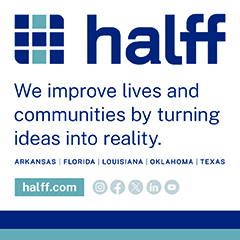At one time, railroads were the predominant mode of travel in America. They still function well, but now hundreds of cities and many states are dealing with rail modifications and roadway revisions because of new safety requirements and other transportation priorities. Trains carry passengers and all kinds of freight, but when they pass through downtown areas and economic corridors, they create congestion that is no longer tolerable. Population growth, new transportation corridors, congestion and public safety — these are the areas of concern.
Billions will be spent as railroad projects are launched throughout the country over the next several years. Some of the projects will launch in smaller towns and be less complicated while others will be extremely large and complex, but they will all present opportunities for contracting firms to help boost economic growth and deliver updated transportation infrastructure in America. Each project will call for engineering, construction, technology, professional services, landscaping and lots of equipment. Examples of upcoming projects follow.
A major infrastructure project designed to address persistent traffic congestion and safety along a downtown rail corridor will launch in Columbia, South Carolina. It carries a projected cost of somewhere between $250 million and $305 million. The existing street-level railroad crossings cause frequent traffic delays, reduced efficiency for rail users and significant risks for vehicle, bicycle and pedestrian traffic.
The city’s rapid growth has increased strain on the transportation network and the project will be designed to improve mobility, reduce delays and eliminate physical and operational conflicts between rail and road traffic. It will involve redesigning the corridor to lower the roadway and provide a structure for freight trains to cross overhead. An environmental assessment is underway, and construction will begin as soon as all permitting is completed. Construction will likely begin late in 2025.
A federally supported railway safety project in New Lenox, Illinois, will upgrade a key north-south corridor. It will call for the elimination of two at-grade railroad crossings that routinely block traffic and delay emergency response efforts. The corridor serves neighborhoods, schools, emergency services and regional healthcare facilities. The project will address recurring congestion, poor traffic flow and collision risk. City leaders will assist with oversight of the comprehensive $52 million reconstruction effort that will call for design standards compliance, a full-depth roadway reconstruction and street widening to provide two lanes in each direction.
Curb and gutter infrastructure will be installed, and a median will be constructed to serve as a refuge island for pedestrians. Accommodation will be made for cyclists and pedestrians by construction of a multi-use path on the east side and a continuous sidewalk on the west side. New traffic signals and signage will be required along with floodplain mitigation and stormwater management work. Construction is scheduled to begin in 2026.
City leaders in Davis, Oklahoma, have announced the upcoming launch of a $31.81 million railroad relocation and crossing mitigation project. It will be designed to address chronic congestion and the associated safety issues caused by prolonged train blockages. The city of Davis serves as the only passing point for trains between North Texas and Purcell, Oklahoma, the county seat of McClain County. It is here that long delays often occur for motorists, emergency vehicles and commercial traffic because of train blockages, which can last from 30 minutes to two hours.
The project will add nearly two miles of new siding track and remove over 4,000 feet of outdated infrastructure. It will also permanently close two at-grade crossings and install upgraded safety features at other crossings. When completed, the effort will eliminate approximately 39,000 vehicle hours of delay each year and lower carbon emissions by over 139 metric tons annually. The project is expected to move into the construction phase by mid to late 2025.
An upcoming $25 million railroad project in the city of Everett, Washington, will address some long-standing issues caused by two at-grade train crossings in the Smith Island industrial area. The crossings create significant traffic delays for freight trucks, private vehicles and emergency responders daily. This work will include the construction of a bridge over the rail line and reconfiguration of adjacent roadways. The new bridge will allow uninterrupted vehicle access over the rail corridor and eliminate waiting for passing trains.
The project will also include work to improve traffic mobility throughout the industrial district, an area that supports critical freight movement and local economic activity. The project’s design will call for a redesigned traffic intersection near the train corridor and the consolidation of other intersections within the area. It will also require modifications to existing stormwater systems and utilities. Solicitation documents will be released as soon as the design phase is completed.
The city of Circleville in Ohio also has a traffic congestion and safety problem because of frequent rail traffic along a high-volume roadway corridor. Dozens of trains travel through the area daily and create disruptions for motorists, emergency responders and school traffic. A $25 million dollar project is being designed to create an elevated roadway to carry traffic over multiple rail lines, which will improve east-west travel through the corridor.
The road project will call for gradual inclines of approximately 700 to 800 feet to meet clearance requirements. Although the alignment will follow the existing route, modifications to connecting streets and surrounding access points will be necessary. Work to update pedestrian connections and sidewalks will also be included. As soon as the engineering work is finalized for the design phase, solicitation documents will be released.
With so many changes taking place at the federal level of government, transportation infrastructure projects will likely be impacted in some ways. Companies interested in these types of contracting opportunities should watch closely for changes that may occur.
Photo/Image Courtesy Canva













